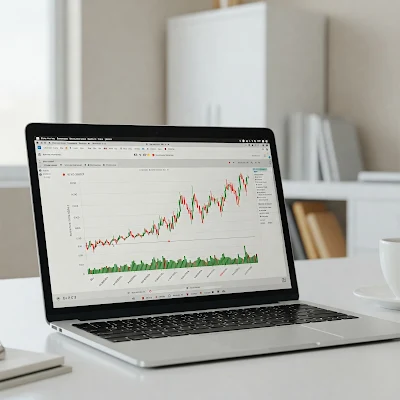Building Your First Stock Portfolio: A Beginner’s Journey to Financial Freedom
A regular 9-to-5er who stumbled into the world of investing a few years ago. Back then, I was clueless about stocks, ETFs, or bonds, but I had a burning desire to grow my money. If you’re a beginner feeling overwhelmed by terms like “portfolio” or “diversification,” this story is for you. I’m sharing my journey of building my first stock portfolio, balancing ETFs, individual stocks, and bonds, and learning to manage risk—all in a way that’s easy to follow. Let’s dive in!
1. Stepping into the Unknown: My First Brush with Investing
A few years ago, I was stashing my paycheck in a savings account, but the measly interest rates left me worried about my financial future. A coworker’s tale of stock market wins sparked my curiosity, but opening a trading app felt like landing on an alien planet. Names like Apple, Tesla, and Amazon popped up, but I had no idea where to start. “Portfolio” sounded like something only Wall Street pros understood.
Then, I stumbled across a beginner’s investing book at a local bookstore. It taught me a golden rule: investing is a marathon, not a sprint. Betting everything on one stock could wipe me out, but a thoughtful approach could set me up for success. That realization lit a fire in me—I was ready to learn.
 |
| < A cozy bookstore with warm lighting > |
2. ETFs: The Beginner’s Best Friend
My first big discovery was ETFs (Exchange-Traded Funds). Think of ETFs as a basket of stocks that track an index, like the S&P 500 or Nasdaq. For a newbie like me, picking individual stocks felt daunting, so ETFs were a game-changer. They let me invest in hundreds of companies with one purchase, spreading my risk without needing a PhD in finance.
I started with an S&P 500 ETF, which includes giants like Apple, Microsoft, and Amazon. It felt like owning a slice of America’s biggest companies! To diversify globally, I added a Total World Stock ETF for exposure to international markets. ETFs are affordable, with low fees, and they gave me a smooth entry into investing.
My initial portfolio looked like this:
- ETFs: 70% (S&P 500 ETF: 50%, Total World Stock ETF: 20%)
- Cash: 30% (because I was still nervous!)
This setup wasn’t flashy, but it kept my stress levels low when the market dipped. ETFs helped me learn the ropes while building confidence.
 |
| < S&P 500 ETF over several years > |
3. Individual Stocks: Adding a Personal Touch
After getting comfortable with ETFs, I wanted to spice things up with individual stocks. Instead of chasing hot tips, I followed advice to invest in companies I understood. I’m a coffee fanatic, so Starbucks was my first pick. Seeing their stores packed gave me confidence in their staying power. I also bought Nvidia, drawn to its role in the booming AI and gaming industries.
But here’s the catch: individual stocks are a rollercoaster. When Nvidia dropped 7% in a day, I panicked. That experience taught me to limit individual stocks to 20-30% of my portfolio. It kept my losses manageable and my sanity intact.
Updated portfolio:
- ETFs: 60% (S&P 500 ETF: 40%, Total World Stock ETF: 20%)
- Individual Stocks: 20% (Starbucks: 10%, Nvidia: 10%)
- Cash: 20%
 |
| < Alex’s decision to invest in Starbucks > |
4. Bonds: The Portfolio’s Safety Net
The stock market’s ups and downs hit me hard in 2022 when my portfolio took a 12% dive. That’s when I learned about bonds, the unsung heroes of investing. Bonds don’t swing wildly like stocks and pay steady interest, acting like a safety net for your portfolio.
I added a U.S. Treasury Bond ETF and a Corporate Bond ETF to my mix. They’re not thrilling, but they stabilize your portfolio when stocks tank. Since I’m in my early 30s, I allocated 20% to bonds, following the “100 minus your age” rule (e.g., at 30, aim for 70% stocks, 30% bonds). As I age, I’ll likely increase my bond holdings.
Final portfolio:
- ETFs: 50% (S&P 500 ETF: 30%, Total World Stock ETF: 20%)
- Individual Stocks: 20% (Starbucks: 10%, Nvidia: 10%)
- Bonds: 20% (U.S. Treasury Bond ETF: 10%, Corporate Bond ETF: 10%)
- Cash: 10%
 |
| < performance of an ETF > |
5. Risk Management: Taming the Emotional Rollercoaster
Investing taught me that my biggest enemy wasn’t the market—it was my own emotions. When stocks soared, I wanted to buy more; when they crashed, I wanted to sell everything. To stay grounded, I set these risk management rules:
- Rebalance Regularly: If stocks grow to 60% of my portfolio, I sell some and buy bonds or ETFs to restore my target ratios.
- Set Loss Limits: For individual stocks, I review or sell if they drop 15% to avoid emotional decisions.
- Think Long-Term: I focus on 5-10 years ahead, ignoring daily market noise.
- Keep an Emergency Fund: I have 6 months’ worth of expenses in savings, so I only invest money I can afford to lose.
6. A Word for New Investors
I’m no Warren Buffett, but I’ve come a long way from my clueless beginner days. The biggest lesson? There’s no one-size-fits-all portfolio, but balance is key. ETFs give you stability, stocks add excitement, and bonds provide security. Start small, keep learning, and don’t let fear hold you back.
Investing isn’t just about money—it’s about understanding the world and building confidence in your financial future. Take that first step, and you’ll be amazed at where the journey takes you!